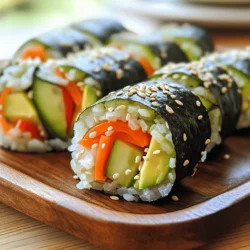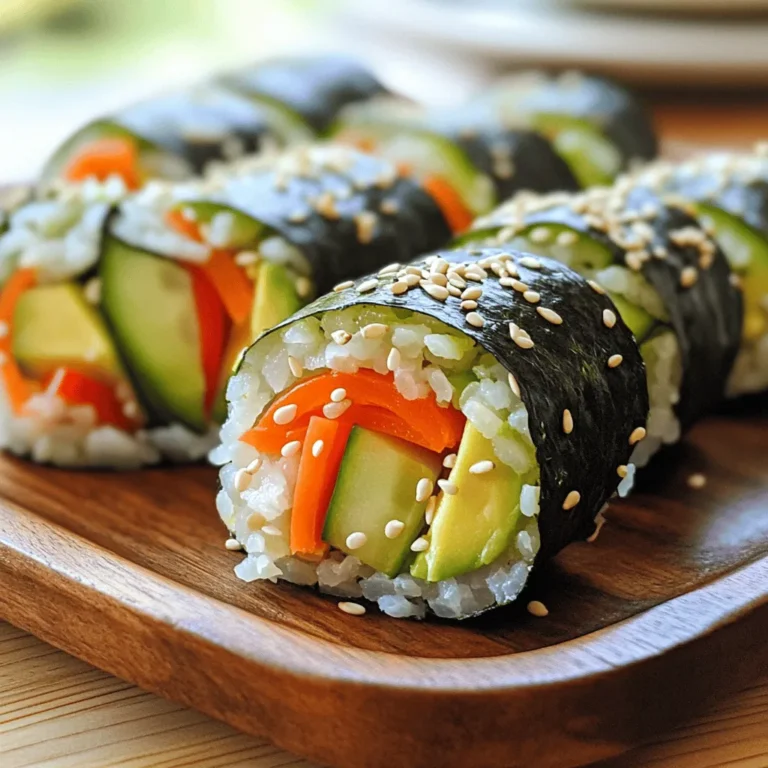If you think sushi is only for experts, think again! In this guide, I’ll show you how to make easy veggie sushi rolls at home. You only need simple ingredients like sushi rice, nori sheets, and fresh veggies. Whether you’re a newbie or just want a quick meal, these steps are simple and fun. Let’s roll up some deliciousness together and impress your friends with your sushi skills!
Ingredients
Essential Ingredients for Easy Veggie Sushi Rolls
– 2 cups sushi rice
– 2 ½ cups water
– ¼ cup rice vinegar
– 2 tablespoons sugar
– 1 teaspoon salt
– 4 sheets of nori (seaweed)
– 1 medium cucumber, cut into thin matchsticks
– 1 medium carrot, cut into thin matchsticks
– 1 ripe avocado, sliced into thin wedges
– ½ red bell pepper, cut into thin matchsticks
– Optional: sesame seeds for garnish
– Optional: soy sauce for dipping
To make easy veggie sushi rolls, you need fresh ingredients. Sushi rice is the base. It sticks well and holds everything together. Rinse it before cooking. This step removes excess starch for the right texture.
Nori sheets wrap your sushi. They add a nice flavor. Make sure to use fresh nori for the best taste.
The veggies are key to flavor and color. I love using cucumber, carrot, avocado, and red bell pepper. Each adds a crunchy bite and fresh taste.
For the rice seasoning, mix rice vinegar, sugar, and salt. This blend gives sushi rice its unique flavor.
You can also add sesame seeds on top. They add a nice crunch. Soy sauce is great for dipping. It enhances the flavor of the rolls.Enjoy making your sushi!
Step-by-Step Instructions
Preparing the Sushi Rice
1. Rinsing sushi rice
Start by rinsing the sushi rice. Place it in a fine-mesh strainer. Rinse it under cold water until the water runs clear. This removes excess starch.
2. Cooking the rice
In a medium saucepan, combine the drained sushi rice with 2 ½ cups of water. Bring it to a boil over medium heat. Then, lower the heat and cover it. Let it simmer for 20 minutes until the water is gone. After that, let it rest for 10 minutes, still covered.
3. Seasoning the rice with vinegar mix
While the rice rests, prepare the seasoning. In a bowl, mix rice vinegar, sugar, and salt. Stir until the sugar and salt dissolve. Once the rice is ready, transfer it to a large bowl. Gently fold in the vinegar mixture. This adds flavor without smashing the rice. Let it cool to room temperature.
Assembling the Sushi Rolls
1. Setting up and preparing your workspace
Get your bamboo sushi mat and place it on a clean, flat surface. Lay a sheet of nori, shiny side down, on the mat.
2. Spreading rice and arranging fillings
With wet hands, spread a thin layer of sushi rice on the nori. Leave about an inch at the top edge. Now, arrange cucumber, carrot, avocado, and bell pepper in a line about 2 inches from the bottom.
3. Rolling technique for sushi
Lift the edge of the bamboo mat closest to you. Roll the sushi away from yourself, keeping the filling in place. Roll it tightly, but not too tight. You want the filling snug inside, but not crushed.
Cutting and Serving
1. Slicing sushi rolls
Once you finish rolling, use a sharp, wet knife to slice the roll. Cut it into 6 to 8 pieces. Wetting the knife helps the rice not to stick.
2. Presentation tips for serving
Arrange the sushi rolls on a plate. Sprinkle sesame seeds on top for a nice touch.
3. Optional garnishes
You can add extra slices of avocado or a sprinkle of sesame seeds for a pretty look. Serve with a small bowl of soy sauce for dipping.
Tips & Tricks
Rolling Techniques
Using a bamboo sushi mat makes rolling easy. Lay the mat flat on your counter. Place a sheet of nori on the mat, shiny side down. Spread rice evenly, leaving space at the top. Keep your hands wet to stop the rice from sticking. Wet fingers help you spread and roll smoothly.
When you roll, start from the bottom edge. Lift the mat and roll away from you. Keep the filling in place as you roll. Aim for a tight roll, but don’t crush it. A good roll holds together without squishing the veggies.
Common Mistakes to Avoid
Watch out for overpacking the fillings. If you add too much, it can break the roll. Use just enough filling for a nice balance.
Rinsing the rice is key. If you skip this step, the rice can be too starchy. Always rinse until the water runs clear. This helps the rice become sticky and perfect for sushi.
Cutting the rolls correctly is also important. Use a sharp knife and wet it before cutting. This prevents the rice from sticking to the blade. Each slice should be clean for great presentation.
These tips will help you make the perfect veggie sushi rolls.

Variations
Filling Variations
You can get creative with your fillings. Seasonal vegetables add freshness and color. Think about using ingredients like:
– Cucumber
– Carrot
– Avocado
– Red bell pepper
For extra protein, try adding tofu or tempeh. They bring a great texture and flavor. You can also use different sauces to spice things up. Consider sesame oil or spicy mayo for added zest.
Sushi Roll Styles
There are fun styles of sushi rolls to try. Futomaki rolls are thick and packed with flavor. Uramaki rolls have the rice on the outside. They look great and taste even better.
Rainbow rolls are a feast for the eyes. You can top them with colorful veggies like avocado, mango, or even edible flowers for a special touch.
You can also make custom vegetarian or vegan rolls. These let you choose your favorite ingredients. Mix and match to create something just for you.
Storage Info
How to Store Leftover Sushi
To keep your leftover sushi fresh, put it in an airtight container. This helps prevent the sushi from drying out. If you have sushi rolls with avocado or other fresh veggies, eat them within 24 hours. These ingredients lose their taste after a day. For rolls with cooked ingredients, like shrimp or crab, you can store them for up to two days. If you need to reheat these types of sushi, use a microwave or steam them gently. This keeps them moist and soft.
Freezing Sushi Rolls
Freezing sushi is easy but requires some care. Wrap each roll tightly in plastic wrap. Then, place them in a freezer bag. This helps to keep out air and prevent freezer burn. You can freeze sushi for up to a month. To thaw, take them out of the freezer and let them sit in the fridge for a few hours. This way, the texture stays nice. Avoid thawing sushi in the microwave, as this can make the rice mushy. Enjoy your sushi later, knowing it still tastes great!
FAQs
How to make sushi rice sticky?
To make sushi rice sticky, rinse it well to remove extra starch. This helps the rice to stick together. After rinsing, cook it with the right water ratio. Use 2 cups of water for every cup of sushi rice. When the rice cooks, let it rest covered for 10 minutes. Then, mix in a bit of rice vinegar, sugar, and salt to make it extra sticky and flavorful.
Can I use brown rice for sushi rolls?
Yes, you can use brown rice for sushi rolls. Brown rice has a nutty flavor and a chewier texture than white sushi rice. It takes longer to cook, so adjust the cooking time to about 40-50 minutes. Make sure to rinse it well before cooking. Keep in mind that brown rice may not be as sticky as white rice, so your rolls might be a bit fragile.
What vegetables work best in sushi?
You can use many vegetables in sushi. Some of my favorites include:
– Cucumber
– Carrot
– Avocado
– Red bell pepper
– Spinach
– Asparagus
– Radish
These veggies add color, crunch, and flavor. Feel free to mix and match to find your favorite combinations.
How long does homemade sushi last?
Homemade sushi lasts about one day in the fridge. Store it in an airtight container to keep it fresh. The rice may dry out or get hard if left too long. If you have leftover sushi with cooked ingredients, it can last up to two days. Always check for signs of spoilage before eating.
Is it necessary to use a sushi mat?
Using a sushi mat makes rolling easier and more uniform. It helps you create tight rolls without squishing the ingredients. However, if you don’t have one, you can still roll sushi by hand. Just be gentle, and try to keep the roll tight and even.
Can I make sushi rolls without nori?
Yes, you can make sushi rolls without nori. You can use thin slices of cucumber or rice paper instead. This option is great for those who don’t like seaweed. Simply wrap your fillings in these alternatives and roll them up. They still taste amazing!
You can make easy veggie sushi rolls at home using simple ingredients. Start with sushi rice and fresh vegetables like cucumber and avocado. Follow the step-by-step guide to cook and season your rice, assemble your rolls, and present them beautifully. Remember to avoid common mistakes for the best results. Finally, explore filling variations and storage options to enjoy sushi even longer. Making sushi is fun, healthy, and rewarding. Try it out and enjoy your delicious creations!


